Sorry, this entry is only available in French.
Tourments d’amour, culinary specialty of Les Saintes
Guadeloupe gastronomy brings together many traditional dishes with beautiful Creole flavors that make you salivate. Among these dishes, Torments of Love ranks among the TOP 5 delicacies of the archipelago to be tasted without hesitation.

Specialty of the Antilles and mainly of Les Saintes, you will fall under the spell of this essential dessert whose recipe has been protected since 2013 by the municipality of Terre-de-Haut.
The cake is broken down by a base of sweet, broken or puff pastry on which we add a jam, traditionally a coconut jam and a sponge cake flavored with cinnamon.

You have to go back to the 1920s to know the origin of this dessert created by Ms. Thomas, a young pastry chef who delighted many diners at banquets. Concerning the name “Tourment d’Amour”, several legends are known… The first would tell that the name was found by a woman tormented by the abandonment of her husband who left to fish regularly at sea. The other story explains that the one who invented the cake would have done it to satisfy her husband returning from fishing who would have endured torment away from her. Thus, the sweet jam and creaminess of the cake would reward his fatigue and emotion.
So if you want to take an excursion to Les Saintes, it is impossible to leave the archipelago without tasting a Tourment d’Amour, there is something for everyone! They are sold directly in the street by the cooks of Saintoises, near the port, in large wicker baskets.
Our recipe for the famous Daiquiri Cocktail, reviewed by our expert in mixiology !
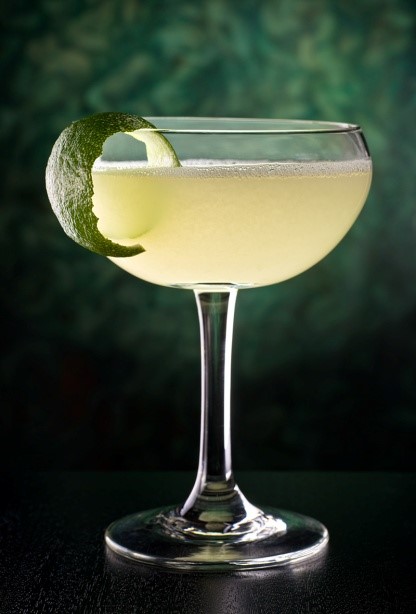
Why not fly to the Caribbean Islands and enjoy this Cuban cocktail, which can be declined according to desires ?
Our Mixology expert will amaze by revisiting the best classic cocktails ! At Le Jardin Malanga, in Guadeloupe, we create cocktails for you in prder to blend flavours. A true journey of original flavors.
Today, our expert unveils his recipe for the famous Daiquiri cocktail.
By the way, several legends are appropiating the creation of this cocktail. The most famous explains that at the beginning of the 20th century, an engineer named Pagliuchi visited an iron mine in Daiquiri, in eastern Cuba. He is received by an American engineer. After the visit, the American would have liked to offer his guest a drink but he had only rum, sugar and lemons in store… ! The Daiquiri would have been born like that.
Did you know ? The Cuban cocktail is so famous that is now has its own day : the 19th of July is officially Word Daiquiri Day !
Don’t wait and take your shaker !
Ingredients :
- 4cl white rum
- 2cl lime juice
- 1cl cane sugar syrup
Preparation :
Fill half a shaker with ice.
Pour all the ingredients into a shaker.
Shake it all and pour it in a Martini glass.
Many variations are possible but our favorite is the Mango version, with mango freshly picked from the garden. The trick to this variation is to add 1.5 cl of mango purée.
Other versions are also delicious, one sweeter and Creole, the other more traditional :
- A Banana version with two banana slices to add. It is better to mix and not to shake to get a smoother texture.
- A Frenchy version with 2cl of orange liqueur and 1.5cl of orange juice to add.
Up to you to choose you favorite version or to find yours to impress your guests…
The advise of our Expert at Le Jardin Malanga : be careful not to test too many versions and to drink responsibly !
The 10 essential flavours of Guadeloupe
Creole cuisine is a blend of flavors, spices and recipes of different origins. Our top 10 to try before you leave.
Cod or malanga (vegetarian) acras
Often served with a spicy sauce, these fritters made with fish, usually cod, seafood or root vegetables, are flavored with spices and chilli peppers and can be enjoyed as an aperitif.
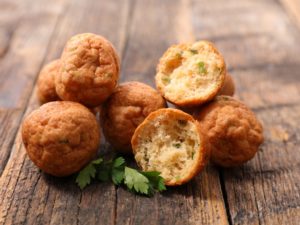
Creole-style black pudding
Made mainly from pig’s blood, bread, West Indian bay and various herbs and spices, this is a very old charcuterie dish. It is traditionally eaten at Christmas.

Smoked chicken
For this typical dish, the poultry is first marinaded, then smoked over a sugar cane barbecue. It is served with “dog” sauce (made of onions, chilli peppers, oil and lemon), rice, and yams or sweet potatoes. Mouthwatering!

Planteur punch and ti-punch
The sweet and fragrant Planteur punch is a cocktail of fruit juice, cane syrup, Angostura bitters, lemon and white and mature rums. For spirit drinkers, ti-punch is neat rum with cane sugar and lemon. Alcohol can damage your health.

Coconut sorbet
This is a delicate artisanal icecream obtained from fresh coconut flesh which is pressed and flavored with cinnamon, vanilla and lime zest, using an icecream maker equipped with a crank handle. Be sure to try it!
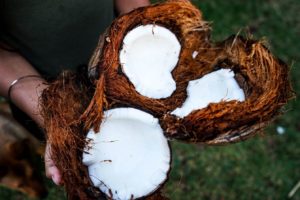
Coconut egg custard
Proposed for dessert in restaurants and on sale in every bakery, this egg custard with coconut is deliciously fresh. It is served with a caramel sauce.

Spices
Star aniseed, cumin, colombo, cinnamon, nutmeg, “vegetarian” chilli pepper, annatto… spices are used to flavor fish, seafood, meat and traditional simmered dishes. Spices make West Indian cuisine a surprising mixture!
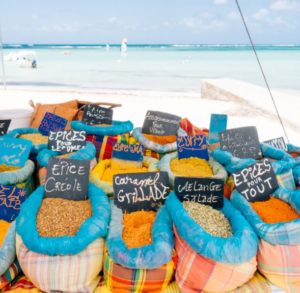
Tropical fruits
The variety of fruit available at the markets makes your mouth water. Our favorites, to be tried depending on the season, are starfruit, banana, mango, maracuja (aka “passion fruit”) and coconut, not forgetting the water lemon and sugar apple.

Street food
If you’re going exploring, try Guadeloupe’s favorite sandwich! The bokit is fried bread roll filled with shredded cod, chicken, ham, cheese, crudités, tuna… whatever you like!

Spicy sauces
“Dog” sauce, Creoline sauce, “enraged” sauce, avocado sauce, smoked-fish sauce, sweet-and-sour sauce… they add flavor to any dish. Learn to use them sparingly, or they’ll bring tears to your eyes!
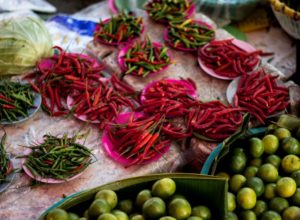
Faustine François
Everything you need to know about banana !
Bananas are good for mental and physical health, and they provide energy… but they also contribute largely to the island’s economy! Focus on a fruit of many virtues.

History
The banana was brought to Martinique by the Portuguese in the 16th century. But it was of little importance in Guadeloupe until the 20th century. In 1928, a cyclone ravaged the coffee and cocoa plantations. That is when the first banana trees were planted, but it was in the sixties that banana production developed significantly.
Distinctive features
The banana “tree” is in fact a giant herbaceous plant. Once plant – ed, the young banana plant takes nine months to reach full fruit-producing maturity. When it does, the banana flower, or “popotte” emerges, followed by a bunch of bananas which will be picked nine weeks later. In the meantime, biodegradable plastic bags are used to protect the bananas from birds and insects. The fruit becomes ripe for consumption three to four weeks after being harvested.
Cooking
Bananas are used in numerous West Indian dishes, such as chicken colombo (plantain) and pâtés, or incorporat – ed into cheese-topped dishes cooked in the oven, made into crisps or Spanish-style fritters, or even blended into cocktails.
Organic cultivation
Nowadays, banana growers are taking care to limit the use of pesticides. More and more, they are committing to organic and sustainable methods. Good to know: banana skins make an excellent fertilizer.
Faustine François
(Français) Le Carpaccio Ananas et son Moelleux au Chocolat du Chef Laurent
(Français) Le Colombo, une spécialité des îles de Guadeloupe
The cooks feast

One day at the deep of the Creole traditions
Each year, on the 10 of August, the ladies take over the power in Guadeloupe highlighting the rich culture and tradition of the islanders. Fans of food will mostly remember the delicious dishes, all those local specialties with flavors that will ignite your nostrils, awake you bud taste and open your appetite like no others.

The Cook feast is more than just that.
From Generation to generation, the cook ladies cultivate the spirit of the Tradition in a fraternal way, as a reminder of the essence of this movement. This association counts over 200 female chefs, from 14 to 97 years old who proudly show off their islander identity wearing their traditional costumes which are famous for their bright colors and delicately knotted hats that they wear with elegance and certainty.
For over a century, this tradition comes alive every year since the source of this popular movement on the 14 of July 1916.
Beginning of last century, a maid loses her husband and barely can find enough money to bury her lost husband. The word goes around and earing the story of this widow ‘s situation, 5 ladies decides to find a way to help her. They start to collect from one maid to another and soon, a new saying comes to town: the « Cuistot Mutuel » (mutuality chef). This became the first mutual funds organization in Guadeloupe. This guarantee to its members to have a decent burial upon their death. Since then, the Ladies’ cook carry on this tradition and offers their services at funerals.

The true watchdog of the tradition
Over the years, these ladies have built a strong association defending with pride the culinary tradition of the islands along with the traditional costumes and ceremonial rites in Guadeloupe. True watch dog of the Guadeloupean culture, this ladies wear with pride their handmade traditional costumes, easily noticeable by the hand stitched apron with the effigy of St Laurent, their saint.
Some would say you have to have a certain does of humor to use St Laurent as your patron saint.
Father Laurent de Rome was condemned to be burn live because he refused to give away to Rome the treasures of the church to feed the army of the empire. The legend says that his last words were:
« Here we go, miserable soul, now that you have grilled one side of me; turn it over then eat. »
…and there he becomes the Patron saint of the chefs, cook and the meat grillers!

La procession : time to share and joy for all
After the mass, the ladies Chefs meet at the entrance of the cathedral in their traditional colored costumes. Lining up to start the procession, the chefs carry various local dishes, baskets filled with local fruits and vegetables, kitchen utensils and other local delicacies. The president and her assistants announce the beginning of the festivities by shaking a serenade of bells and start the march. At each street corner, they announce their presence and give away the best meals along the procession. They will go all over cross town singing along the way at the rhythm of the Gwo Ka and sharing with the locals, including some amazing cakes and sweets!



Then, it is time to all meet for the outdoor food festival. The ladies Chef (Cordon Bleu) will make you taste their specialties and creativity of their unique artistic skills (there is a charge for lunch) One of the best gastronomic experience in the island! later on, music will take over and dancing through the night will be the ultimate finale.
Happy hour 100% Creole
In order to enjoy a true vacation time in the Caribbean, you need to jump immediately into the Fun!
One way to do it is to start Happy Hour with the famous Ti’ Punch, a local and favorite cocktail of the islanders!
There are many recipes for this island cocktail but this one below is tested and approved!

Traditionally, Ti-Punch is made of white rum but you can also do it with an Amber rum if you want some delicate woody flavors ! then add brown sugar cane or even better a sugar cane syrup ; you can even do you sugar cane syrup yourself for a special touch.

Homemadee sugar can syrup
- 2lbs of brown sugar
- 4 limes
- 2 vanilla sticks (split in 2)
- 2 pinches of cinnamon
- 1 pinch of nutmeg
- 2 cloves
- 1 orange zest
- 1 pinch of black pepper
It will take you only 2 minutes to prepare and 30 minutes to cook. Put all the ingredients at once in a pan and cover with the same amount (level) of water. Put the pan on a low fire for half an hour mixing it regularly with a wood spoon. Once you deep your spoon in the sauce pan and you obtain a single fillet of slightly thick liquid (syrup) going down your spoon, it is ready. If you do not obtain the syrup like drop after half an hour of cooking, add some more time under the fire until you get the perfect smooth syrup. Once you have the right consistency, pass the liquid though a metal « Chinois » strainer. Pour the syrup into a glass bottle or a ball glass jar; you can keep it in a fridge for several months.

Back to the ti-punch !
For 1 person, in a short wide glass (like a whisky glass)
- 1 inch of white rum or amber rum
- ¼ inch of syrup or 3 tea spoon of brown sugar
- 1 slice of lime
How to prepare it directly in your glass.
Add the syrup or brown sugar first, then press the lime onto it (It also helps melting the brown sugar. Then add the rum. Mix it with a tea spoon. You can also add a slice of lime on the glass edge for decoration.
We usually drink the Ti-Punch with no ice… and it is very good with Accras as an appetizer.

Accras donuts
An easy recipe that will take you only 20 minutes to achieve.
For 15 accras
- A quarter pond of salted cod fish (You will need to de-salt it before use by rinsing it and letting the fish sit in a bowl of water for a few hours before use)
- 4 tablespoons of flour
- 1 tea spoon of yeast
- ½ shallots
- 1 garlic clove
- 1 few strings of chive finely chopped
- 1 branch of parsley (curly parsley is preferred)
- ½ juice of a lime
- 1 pinch of 4 spices or ½ tea spoon of hot sauce or a ¼ of a finely diced hot pepper
- Half a glass of water or milk
- Oil to fry

Preparation
Once you have de-salted the cod fish then steamed it or boiled it, shredded it in pieces into a bowl. Add the spices, the herbs, the shallots and garlic finely chopped and the lime juice. Mix it all very well. Mix the flour with the yeast and add it to the bowl. Mix it well. Add the water step by step and mix to obtain a nice dough.
Heat up the oil.
With a tea spoon, create some balls of the dough and drop it in the hot oil. Let it cook to a golden color.
Once cooked, display them on a metal sheet with a layer of paper towel to absorb the excess of oil.

Enjoy it warm!

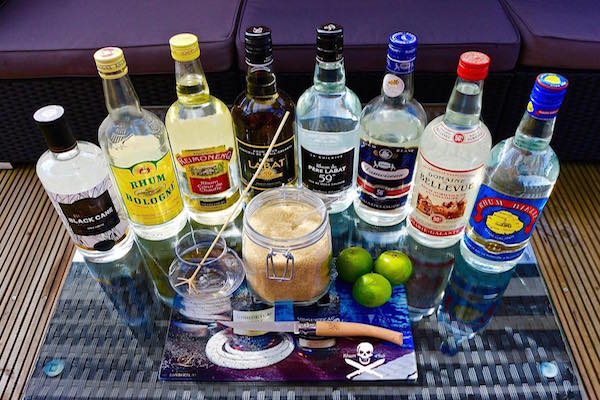




 Book the hotel directly
Enjoy the best guarantees and best offers
Book the hotel directly
Enjoy the best guarantees and best offers
 The best price
The best price No booking fees
No booking fees  Secured payment
Secured payment  An expert at your attention
Need help organizing or booking your stay?
An expert at your attention
Need help organizing or booking your stay?







 An expert at your attention
Need help organizing or booking your stay?
An expert at your attention
Need help organizing or booking your stay?